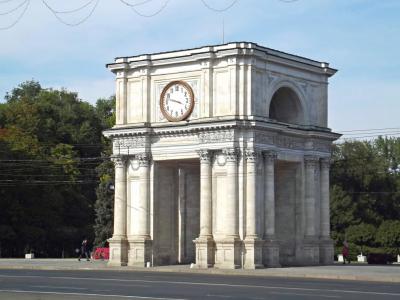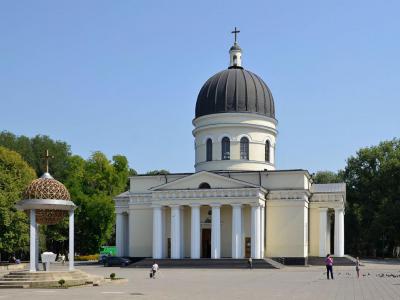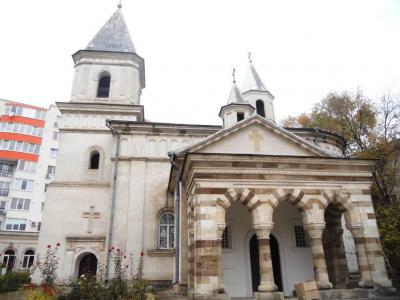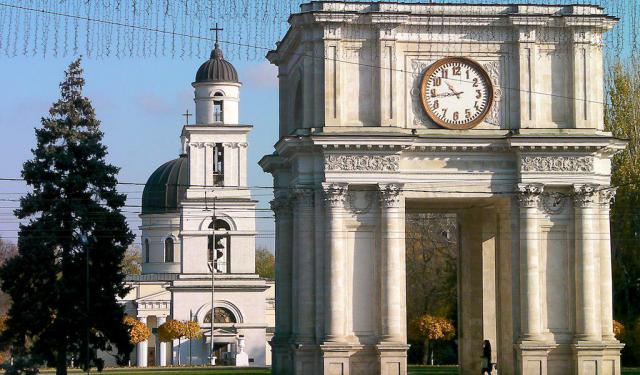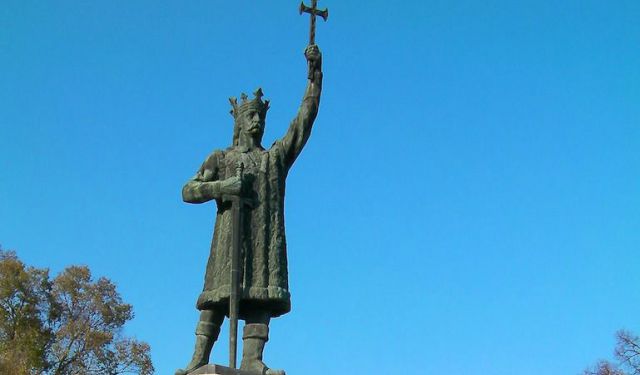
Chisinau Historical Sites (Self Guided), Chisinau
Although the history of Chisinau accounts for just over 500 years, whilst that of Moldova, as a nation, even less than that – since 1991, Moldovan culture and language are deeply rooted in the ancient Roman tradition. Just as the Eternal City, Chisinau rests on seven hills – in the valley of the River Bic, and has a replica statue of the Capitoline Wolf in the downtown area. Whereas most of Chisinau's attractions aren't found in any international tourist guides, they still have rather interesting stories behind them.
Chisinau Spring Monument – marks the birthplace of the city as a monastery village built around a small spring in 1436; reportedly this fact gave the city its name – the archaic Romanian word chișla means a "source of water", and nouă means "new".
Stephen the Great Monument – erected in 1927 to commemorate Moldova's prince Stefan cel Mare who fought against the Ottoman rule in the 15th century. The monument stands outside the park named in his honor.
The Nativity Cathedral – built in 1830-1836, symbolizes a new chapter in the history of Chisinau as the capital of Bessarabia within the Russian Empire.
Bell Tower – first built in 1830, the magnificent belfry was demolished by the Soviets in the 1960s; rebuilt in 1998.
Triumphal Arch – one of the key local landmarks, created in 1846 to celebrate Russia's victory in the Russo-Turkish War of 1806–1812.
Pushkin House Museum – a house in which Russian poet Alexander Pushkin lived during exile to Bessarabia in the 1820s.
Also in Chisinau there is a huge number of religious monuments of different periods, such the Armenian Church, Mazarachi Church and more.
To visit these and other notable attractions of Chisinau, take this self-guided walking tour.
Chisinau Spring Monument – marks the birthplace of the city as a monastery village built around a small spring in 1436; reportedly this fact gave the city its name – the archaic Romanian word chișla means a "source of water", and nouă means "new".
Stephen the Great Monument – erected in 1927 to commemorate Moldova's prince Stefan cel Mare who fought against the Ottoman rule in the 15th century. The monument stands outside the park named in his honor.
The Nativity Cathedral – built in 1830-1836, symbolizes a new chapter in the history of Chisinau as the capital of Bessarabia within the Russian Empire.
Bell Tower – first built in 1830, the magnificent belfry was demolished by the Soviets in the 1960s; rebuilt in 1998.
Triumphal Arch – one of the key local landmarks, created in 1846 to celebrate Russia's victory in the Russo-Turkish War of 1806–1812.
Pushkin House Museum – a house in which Russian poet Alexander Pushkin lived during exile to Bessarabia in the 1820s.
Also in Chisinau there is a huge number of religious monuments of different periods, such the Armenian Church, Mazarachi Church and more.
To visit these and other notable attractions of Chisinau, take this self-guided walking tour.
How it works: Download the app "GPSmyCity: Walks in 1K+ Cities" from Apple App Store or Google Play Store to your mobile phone or tablet. The app turns your mobile device into a personal tour guide and its built-in GPS navigation functions guide you from one tour stop to next. The app works offline, so no data plan is needed when traveling abroad.
Chisinau Historical Sites Map
Guide Name: Chisinau Historical Sites
Guide Location: Moldova » Chisinau (See other walking tours in Chisinau)
Guide Type: Self-guided Walking Tour (Sightseeing)
# of Attractions: 8
Tour Duration: 3 Hour(s)
Travel Distance: 5.5 Km or 3.4 Miles
Author: ann
Sight(s) Featured in This Guide:
Guide Location: Moldova » Chisinau (See other walking tours in Chisinau)
Guide Type: Self-guided Walking Tour (Sightseeing)
# of Attractions: 8
Tour Duration: 3 Hour(s)
Travel Distance: 5.5 Km or 3.4 Miles
Author: ann
Sight(s) Featured in This Guide:
- Stefan the Great Monument
- Triumphal Arch
- Bell Tower
- Nativity Cathedral
- Pushkin House Museum
- Armenian Church
- Mazarachi Church
- Chisinau Spring Monument
1) Stefan the Great Monument (must see)
The bronze monument of Stefan the Great (or Stefan cel Mare as it's known locally) outside the main entrance to the park bearing the same name in downtown Chisinau commemorates Moldova's national hero – the ancient ruler, who, in the 15th century, successfully defended the country from Turkish invasion. The statue was cast in Bucharest in the early 20th century and was intended to replace the monument to the Russian Emperor Alexander II which had previously stood in this place and was demolished by Romanian authorities after Moldova had joined the Romanian Kingdom in 1918.
The sculpture was created by Alexandru Plamadeala who had traveled far and wide, prior to starting the job, in order to find a portrait of Stefan cel Mare. They say, the sculptor made three different copies of the monument, one of which stands today. Over the years, the sculpture has been moved several times from place to place. Shortly before the Soviet invasion of Bessarabia in 1940, it was taken to Vaslui in the eastern part of Romania, and then returned to Chisinau in 1942. Then, in 1944, it was once again dispatched to Romania. Finally, after a very long while, in 1989, the monument was restored in its original place in Chisinau. Today, the sculpture represents one of the top tourist sights in Moldovan capital and is a popular meeting point with locals, often visited by foreign guests, wedding couples and others.
The sculpture was created by Alexandru Plamadeala who had traveled far and wide, prior to starting the job, in order to find a portrait of Stefan cel Mare. They say, the sculptor made three different copies of the monument, one of which stands today. Over the years, the sculpture has been moved several times from place to place. Shortly before the Soviet invasion of Bessarabia in 1940, it was taken to Vaslui in the eastern part of Romania, and then returned to Chisinau in 1942. Then, in 1944, it was once again dispatched to Romania. Finally, after a very long while, in 1989, the monument was restored in its original place in Chisinau. Today, the sculpture represents one of the top tourist sights in Moldovan capital and is a popular meeting point with locals, often visited by foreign guests, wedding couples and others.
2) Triumphal Arch (must see)
Also known as the Holy Gate, the Triumphal Arch is yet another historic monument in the heart of Chisinau. It was built in 1846 to commemorate victory of the Russian forces over the Turkish Army in the 1820s. The Arch overlooks the Government House on Stefan cel Mare Boulevard from across the Great National Assembly Square.
The structure has a classic, square-shaped form, 13 meters in height and is distinctly divided into two tiers. The lower tier comprises four sturdy pylons, ornately decorated with classic Corinthian columns, which give the construction its regal look. It also features a beautiful clock on the side, which chimes every fifteen minutes.
Aside from its architectural value, the Arch is also noted for its fascinating history. After the Russians defeated Turks in 1829, Tsar Nikolai I, acting on request of General Vorontsov, one of the most prominent war veterans, ordered to make bells from the captured Turkish canons. These bells were to be installed inside the Arch. However, upon their completion, the bells proved to be too big for the Arch and therefore a separate belfry had to be constructed nearby specially for them.
Why You Should Visit:
Historical significance aside, it is quite refreshing to find a monument of this type in Moldova. You can't go in it or up it, but it gives a little relief to the city itself.
Quite successful in its miniature form and a must-see of the Moldavian Champs-Élysées as it marks the dead center of the city.
Tip:
Take a walk to see it at dusk, when it is beautifully lit. You can also spend some time in the very nice park nearby.
The structure has a classic, square-shaped form, 13 meters in height and is distinctly divided into two tiers. The lower tier comprises four sturdy pylons, ornately decorated with classic Corinthian columns, which give the construction its regal look. It also features a beautiful clock on the side, which chimes every fifteen minutes.
Aside from its architectural value, the Arch is also noted for its fascinating history. After the Russians defeated Turks in 1829, Tsar Nikolai I, acting on request of General Vorontsov, one of the most prominent war veterans, ordered to make bells from the captured Turkish canons. These bells were to be installed inside the Arch. However, upon their completion, the bells proved to be too big for the Arch and therefore a separate belfry had to be constructed nearby specially for them.
Why You Should Visit:
Historical significance aside, it is quite refreshing to find a monument of this type in Moldova. You can't go in it or up it, but it gives a little relief to the city itself.
Quite successful in its miniature form and a must-see of the Moldavian Champs-Élysées as it marks the dead center of the city.
Tip:
Take a walk to see it at dusk, when it is beautifully lit. You can also spend some time in the very nice park nearby.
3) Bell Tower
Situated directly behind the Holy Gates, opposite the Cathedral, is a beautiful bell tower, an important religious and historic site in Chisinau.
This Belfry is the exact replica of its predecessor that was built on this site in the 1830s (along with the nearby Cathedral). The original tower was fitted with the bells made from the Turkish cannons captured during the Russo-Turkish war of 1828-1829.
Sadly, the first belfry was demolished in 1962, during the Soviet reign, under Nikita Khrushchev, and was replaced with a flower bed. Officially, this was done in a bid to prevent anybody from using the tower as a firing position should anyone ever contemplated murdering government officials sitting in the Government House on the opposite side of the square.
In the post-Soviet era, in 1998, the bell tower was rebuilt. It stands four stories high, has several bells at the top, and a small chapel on the ground floor.
Tip:
Note the surrounding flowerbeds; if you want to buy flowers, check out the stalls on the side of the park.
This Belfry is the exact replica of its predecessor that was built on this site in the 1830s (along with the nearby Cathedral). The original tower was fitted with the bells made from the Turkish cannons captured during the Russo-Turkish war of 1828-1829.
Sadly, the first belfry was demolished in 1962, during the Soviet reign, under Nikita Khrushchev, and was replaced with a flower bed. Officially, this was done in a bid to prevent anybody from using the tower as a firing position should anyone ever contemplated murdering government officials sitting in the Government House on the opposite side of the square.
In the post-Soviet era, in 1998, the bell tower was rebuilt. It stands four stories high, has several bells at the top, and a small chapel on the ground floor.
Tip:
Note the surrounding flowerbeds; if you want to buy flowers, check out the stalls on the side of the park.
4) Nativity Cathedral (must see)
The Nativity Cathedral in Chisinau is a fine piece of Russian architecture, dating back to the early 19th century. Just like most religious sites in the city during the Soviet period, the Cathedral building was converted to a secular use and served as an exhibition center. Following the collapse of the Soviet Union, it has resumed service as a place of worship for the local Orthodox congregation.
Construction on the Cathedral was commissioned by Prince Mikhail Semyonovich Vorontsov, the governor-general of Novorossiya (or New Russia) region of the Russian Empire back in the 1830s, and was led by architect Avraam Melnikov, one of the country's finest architects at the time. Given the importance of the project, great care was taken to ensure the building's elegant, regal and timeless appearance. As such, the Cathedral features eclectic style, a combination of Byzantine elements with a hint of Renaissance on a Greek Cross, which is a perfect brew for neoclassical design.
Over the centuries, this remarkable edifice has sustained multiple damages caused by wars and political upheavals following the demise of, first, the Russian Empire and then the Soviet Union. Today, the Cathedral stands as the main temple of the Russian Orthodox Church in Chisinau and is a definite must-see attraction for any architecture buff visiting the city.
Why You Should Visit:
Set in front of the nice square (good for meditating and/or people watching), the structure appears quite large and simple from the outside, but on the inside it is rather small, yet brightly lit – a perfect example of Orthodox cathedral architecture.
Construction on the Cathedral was commissioned by Prince Mikhail Semyonovich Vorontsov, the governor-general of Novorossiya (or New Russia) region of the Russian Empire back in the 1830s, and was led by architect Avraam Melnikov, one of the country's finest architects at the time. Given the importance of the project, great care was taken to ensure the building's elegant, regal and timeless appearance. As such, the Cathedral features eclectic style, a combination of Byzantine elements with a hint of Renaissance on a Greek Cross, which is a perfect brew for neoclassical design.
Over the centuries, this remarkable edifice has sustained multiple damages caused by wars and political upheavals following the demise of, first, the Russian Empire and then the Soviet Union. Today, the Cathedral stands as the main temple of the Russian Orthodox Church in Chisinau and is a definite must-see attraction for any architecture buff visiting the city.
Why You Should Visit:
Set in front of the nice square (good for meditating and/or people watching), the structure appears quite large and simple from the outside, but on the inside it is rather small, yet brightly lit – a perfect example of Orthodox cathedral architecture.
5) Pushkin House Museum (must see)
The great Russian poet Alexander Pushkin was exiled to Bessarabia (nowadays Moldova) for three years by the tsarist administration. He arrived in Chisinau on September 21, 1820, and stayed at the house of General Inzov, which today hosts the museum of Pushkin and is one of only two remaining Pushkin houses in the world; the other being is at Moika, St. Petersburg, Russia. Over the three years that Pushkin spent in Bessarabia, he had written a number poems, including the first part of the world-famous "Eugeny Onegin" and many others.
While in Chisinau, Pushkin maintained close ties with the local cultural elite: the writer Constantin Stamati, the Donici family, and other classics of the Romanian literature. The museum holds a collection of materials related to Pushkin's life in Bessarabia such as prints, paintings, sculptures, decorative art pieces from the late XVIII-XIX centuries, as well as editions of some of his works written here.
While in Chisinau, Pushkin maintained close ties with the local cultural elite: the writer Constantin Stamati, the Donici family, and other classics of the Romanian literature. The museum holds a collection of materials related to Pushkin's life in Bessarabia such as prints, paintings, sculptures, decorative art pieces from the late XVIII-XIX centuries, as well as editions of some of his works written here.
6) Armenian Church
According to some sources, the Armenian church in Chisinau was built on the ruins of an ancient Moldovan temple which burned down along with the rest of the city in 1739. The new, Armenian church was built in its place in 1804.
The architectural plan, featuring the nave with semicircular apse and the bell tower bunk extension to the west, reveals XVIII century construction style. The church's main body represents an elongated box rounded to the east and the high bell tower over the west porch, culminating with a tent ceiling. Typically Armenian are the south aisle arches with decorative columns and clean masonry walls. In 1817 two porticoes were added to the church's porch – a three-arched one to the south and a single-arched to the east and west. Their style differs substantially from the rest of the building. Particularly prominent are the portico arches, designed as lancet arches, with peculiar Arab columns and capitals.
The walls, floors and buttresses of the church are made of brick and stone, and are plastered. The foundation is made of quarry-stone. The portico walls – light and dark gray in color – are of pure cut stone. On the outside the church appears solid and monumental. Complementing the main building are the nearby utility structures, together forming a beautiful architectural ensemble.
The architectural plan, featuring the nave with semicircular apse and the bell tower bunk extension to the west, reveals XVIII century construction style. The church's main body represents an elongated box rounded to the east and the high bell tower over the west porch, culminating with a tent ceiling. Typically Armenian are the south aisle arches with decorative columns and clean masonry walls. In 1817 two porticoes were added to the church's porch – a three-arched one to the south and a single-arched to the east and west. Their style differs substantially from the rest of the building. Particularly prominent are the portico arches, designed as lancet arches, with peculiar Arab columns and capitals.
The walls, floors and buttresses of the church are made of brick and stone, and are plastered. The foundation is made of quarry-stone. The portico walls – light and dark gray in color – are of pure cut stone. On the outside the church appears solid and monumental. Complementing the main building are the nearby utility structures, together forming a beautiful architectural ensemble.
7) Mazarachi Church
Although Chisinau may be a fairly new addition to the list of tourist destinations in Europe, it surely deserves a mention owing to its rustic appeal, specific architecture and lush greenery. The latter has earned Chisinau the title of one of the greenest cities in Europe. The word “Chisinau” translates from Romanian as a “new spring” where chișla means "spring" ("a source of water") and nouă means “new". It thus can be deduced that the city evolved from a settlement formed around a spring. At the foot of the hill, that houses the Mazarachi Church, lies a stone which marks the location of the spring for which the city has been named.
This church is one of the oldest structures in Chisinau. A historic monument of national importance, it was built by Vasile Măzărache in 1752. The building features a typical medieval Moldovan style, standing somewhat humbly over the spring that has given birth to the city. Dedicated to the Mother of God, Virgin Mary, the Mazarachi Church is one of the best examples of Russian Orthodox architecture in Chisinau. For tourists, this can be a good starting point for a historical tour of the city.
This church is one of the oldest structures in Chisinau. A historic monument of national importance, it was built by Vasile Măzărache in 1752. The building features a typical medieval Moldovan style, standing somewhat humbly over the spring that has given birth to the city. Dedicated to the Mother of God, Virgin Mary, the Mazarachi Church is one of the best examples of Russian Orthodox architecture in Chisinau. For tourists, this can be a good starting point for a historical tour of the city.
Image Courtesy of Jim.
8) Chisinau Spring Monument
While the actual origin of the city name – Chisinau – is subject to a debate, some historians reckon it can be attributed to the expression "chisla noua" which is the archaic Romanian for "new spring". The presumed site of the water spring from where Chisinau started – at the foot of the hill crowned by the Mazarache Church – is marked by a memorial foundation stone. They say, Russian poet Alexander Pushkin frequented this spring when visiting the church during his exile to Moldova in the early 1800s.
Chisinau itself was first documented, along with the spring by Mazarache Hill near the Bic river, in a deed drawn on July 17, 1436 in Vaslui (today's Romania). According to this document called the Royal Book of Reinforcement, the lords of Moldova – Ilie and Ștefan the Great – established place for the nascent town of Chisinau with the houses to be built on the right side of the Bic, “in the valley by the spring where there is an opening near the forest.”
Presently, the Foundation date of July 17 is usually overshadowed by that of October 14, which is the official Day of the City of Chisinau, a religious holiday celebrated each year.
The commemorative stone was first installed in 1986 and originally bore inscription in the Cyrillic script. Following Moldova's Independence, 20 years later the stone was renovated with the inscription changed into the Latin script.
Chisinau itself was first documented, along with the spring by Mazarache Hill near the Bic river, in a deed drawn on July 17, 1436 in Vaslui (today's Romania). According to this document called the Royal Book of Reinforcement, the lords of Moldova – Ilie and Ștefan the Great – established place for the nascent town of Chisinau with the houses to be built on the right side of the Bic, “in the valley by the spring where there is an opening near the forest.”
Presently, the Foundation date of July 17 is usually overshadowed by that of October 14, which is the official Day of the City of Chisinau, a religious holiday celebrated each year.
The commemorative stone was first installed in 1986 and originally bore inscription in the Cyrillic script. Following Moldova's Independence, 20 years later the stone was renovated with the inscription changed into the Latin script.
Walking Tours in Chisinau, Moldova
Create Your Own Walk in Chisinau
Creating your own self-guided walk in Chisinau is easy and fun. Choose the city attractions that you want to see and a walk route map will be created just for you. You can even set your hotel as the start point of the walk.
Stefan cel Mare Blvd Walk
Stefan cel Mare Boulevard is arguably the most prominent streets of the Moldovan capital. The 3.8-km thoroughfare is lined with numerous buildings of social and political importance, cultural institutions, shops, and restaurants.
Historically, it is believed to have stemmed from the road that led into the city from the Russian military camp stationed to the west of Chisinau in 1789. Long before... view more
Tour Duration: 2 Hour(s)
Travel Distance: 3.6 Km or 2.2 Miles
Historically, it is believed to have stemmed from the road that led into the city from the Russian military camp stationed to the west of Chisinau in 1789. Long before... view more
Tour Duration: 2 Hour(s)
Travel Distance: 3.6 Km or 2.2 Miles
Best Wine and Brandy Shops
Given the lack of stunning scenery – no turquoise waters or snow-clad mountains – Moldova is a country not overrun by tourists. Still, those who come here, usually do so to taste the local wines and brandies – Moldova is a seasoned grape and spirit producer. The locals are very lovable and hospitable people, genuinely ready to delight strangers with their internationally-renowned booze. Here... view more
Tour Duration: 1 Hour(s)
Travel Distance: 3.0 Km or 1.9 Miles
Tour Duration: 1 Hour(s)
Travel Distance: 3.0 Km or 1.9 Miles
Bernardazzi Architecture Walking Tour
Talented people are often able to leave their mark in the hearts of the posterity long after they are gone. Centuries fly but the power of the beauty persists, especially if set in the stones of the buildings designed by distinguished architects. Moldova's capital is blessed in this respect as the place associated with Alexander Bernardazzi, a Russian architect of Swiss-Italian descent who... view more
Tour Duration: 1 Hour(s)
Travel Distance: 2.4 Km or 1.5 Miles
Tour Duration: 1 Hour(s)
Travel Distance: 2.4 Km or 1.5 Miles
Chisinau Introduction Walking Tour
Chisinau is the capital of Moldova, a small nation in Eastern Europe landlocked between Romania and Ukraine. For many years this land had been part of the Russian Empire and then the Soviet Union, until it finally gained independence in 1991. For this reason the city is also often referred to as Kishinev, which is the Russian version of the name.
While the true origin of the name is unclear,... view more
Tour Duration: 2 Hour(s)
Travel Distance: 2.4 Km or 1.5 Miles
While the true origin of the name is unclear,... view more
Tour Duration: 2 Hour(s)
Travel Distance: 2.4 Km or 1.5 Miles
Useful Travel Guides for Planning Your Trip
Chisinau Shopping Guide: 20 Moldovan Products to Take Home
Once part of the Soviet Union, now independent Moldova is a small country sandwiched between Romania and Ukraine, of which still very little is known. To mend this, the country has recently opened borders to the outside world. Be sure to take advantage of this opportunity and acquaint yourself with...
The Most Popular Cities
/ view all

